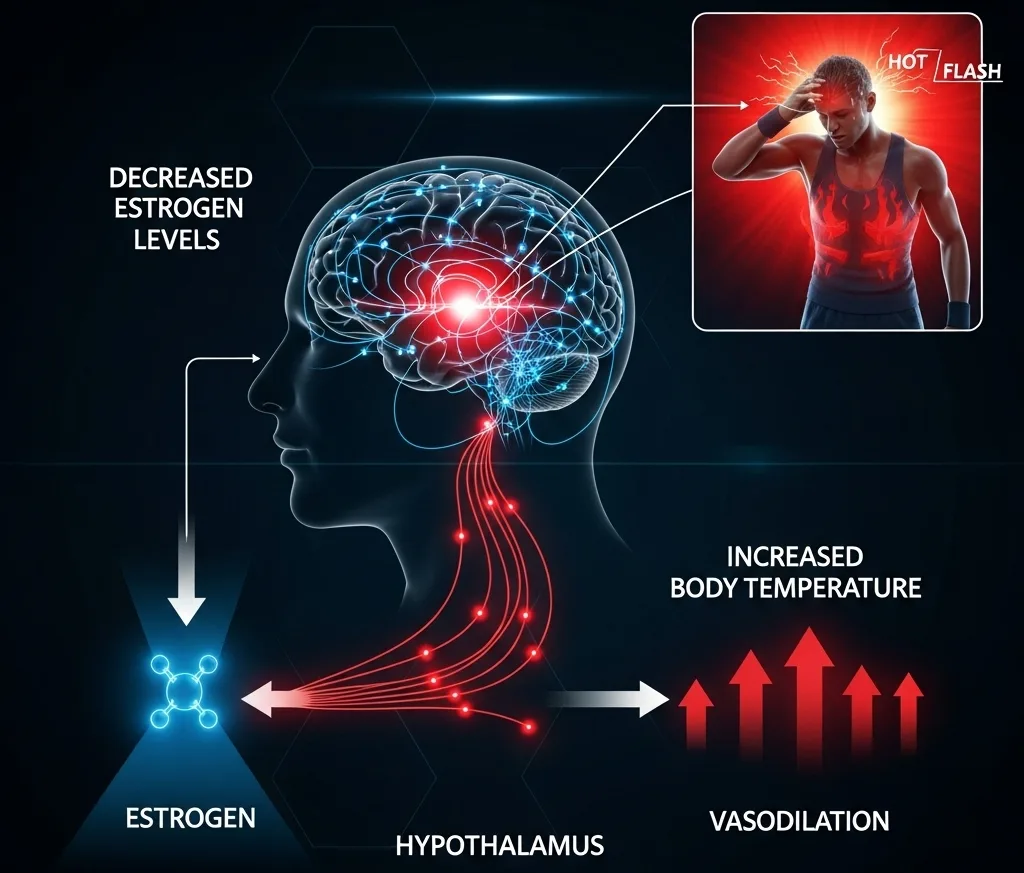Hot flashes are a sudden, intense sensation of heat, often accompanied by sweating and a rapid heartbeat. While most commonly associated with menopause, they can have a significant impact on athletes and active individuals, affecting performance, recovery, and overall well-being. This article will delve into the causes of hot flashes, their specific relationship to sports, potential side effects for athletes, and strategies for management and mitigation.
The Hormonal Basis of Hot Flashes
As the text you provided mentions, hot flashes are a response to a decrease in estrogen levels. The hypothalamus, the part of the brain responsible for regulating body temperature, misinterprets this hormonal shift. It mistakenly believes the body is overheating and triggers a series of events to cool it down, leading to the familiar sensation of a hot flash.
In women, this drop in estrogen is a hallmark of the menopause transition. However, it's important to note that hormonal fluctuations can also occur in athletes for other reasons, such as overtraining, caloric restriction, or certain medical conditions.
The Unique Challenges of Hot Flashes for Athletes
For an athlete, a hot flash isn't just a brief moment of discomfort; it can directly interfere with training and competition.
Temperature Regulation: An athlete's body is already working hard to regulate its temperature during exercise. When a hot flash hits, this system is thrown into disarray. The body's core temperature rises, leading to increased sweating and a feeling of being flushed. This can be especially problematic in hot or humid environments, as it compounds the body's natural response to exercise, potentially leading to overheating.
Performance Impact: The sudden feeling of being weak, dizzy, or having a rapid heartbeat during a hot flash can compromise an athlete's performance. It can disrupt focus, reduce stamina, and even lead to a need to stop or significantly slow down.
Sleep Disruption: Hot flashes that occur at night are known as "night sweats." These can wake an athlete from sleep, leading to fatigue, poor recovery, and a negative impact on the next day's training session or competition. Sleep is crucial for muscle repair and performance, so anything that interferes with it can have a cascading effect on an athlete's health.
Estrogen's Broader Role in Athletic Performance
Estrogen is a vital hormone for female athletes, and its fluctuations have wide-ranging effects beyond hot flashes. Research suggests that estrogen plays a key role in:
Muscle and Bone Health: Estrogen helps maintain muscle mass and strength, and it is crucial for bone density. A decline in estrogen can lead to a decrease in strength and an increased risk of bone loss and fractures.
Endurance and Recovery: Estrogen appears to improve endurance and cardio performance by influencing oxygen intake and circulation. It can also help reduce muscle damage and speed up recovery after a workout.
Ligament and Tendon Health: While estrogen improves bone and muscle function, high levels can also increase the laxity of tendons and ligaments, making athletes more prone to certain injuries, such as ACL tears. This is a complex aspect of hormonal balance that athletes must consider.
Managing Hot Flashes and Hormonal Fluctuations
For athletes experiencing hot flashes or other symptoms related to hormonal shifts, a multi-faceted approach to management is often the most effective.
Lifestyle Modifications:
Trigger Avoidance: Identifying and avoiding personal triggers is a critical first step. Common triggers include spicy foods, caffeine, alcohol, and stress. Keeping a journal can help an athlete pinpoint their specific triggers.
Temperature Control: Athletes can help their bodies stay cool by wearing loose-fitting, moisture-wicking clothing, using fans or air conditioning, and sipping ice-cold water during workouts.
Exercise Management: While regular exercise is beneficial for overall health and can help manage hot flashes, sudden, acute increases in activity or high-intensity workouts can sometimes trigger them. An athlete may consider adjusting their routine to include more moderate-intensity workouts or exercising in a cooler environment.
Mind-Body Techniques: Practices such as deep breathing exercises, mindfulness meditation, or cognitive behavioral therapy (CBT) can help manage the stress and anxiety that can precede or accompany a hot flash.
Medical and Pharmacological Options:
Hormone Therapy: Hormone therapy, which can include estrogen, has been shown to be effective in relieving the discomfort of hot flashes for many women. It's essential for athletes to consult with a healthcare professional to discuss the potential benefits and risks.
Non-Hormonal Medications: For athletes who cannot or choose not to use hormone therapy, non-hormonal prescription medications may be an option. These can include certain antidepressants, anti-seizure medications, and other drugs that act on the brain's temperature-regulating system.
Nutritional Adjustments: A balanced diet rich in protein, complex carbohydrates, and healthy fats is crucial for hormonal balance and overall performance. Some studies suggest that a diet rich in plant estrogens, such as those found in soy products and whole grains, may also help with hot flash symptoms.
Conclusion
Hormonal fluctuations and hot flashes are not just a part of aging; they are a physiological reality that can significantly impact athletes. By understanding the underlying causes and their specific effects on performance, athletes can proactively manage their symptoms. Combining strategic lifestyle changes with professional medical advice, they can continue to train effectively, recover properly, and perform at their peak, regardless of where they are in their hormonal journey.

